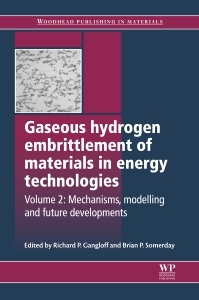Description
Gaseous Hydrogen Embrittlement of Materials in Energy Technologies
Mechanisms, Modelling and Future Developments
Woodhead Publishing Series in Metals and Surface Engineering Series
Coordinators: Gangloff Richard P, Somerday Brian P
Language: English
Subject for Gaseous Hydrogen Embrittlement of Materials in Energy...:
Support: Print on demand
Description
/li>Contents
/li>Comment
/li>
Volume 2 is divided into three parts, part one looks at the mechanisms of hydrogen interactions with metals including chapters on the adsorption and trap-sensitive diffusion of hydrogen and its impact on deformation and fracture processes. Part two investigates modern methods of modelling hydrogen damage so as to predict material-cracking properties. The book ends with suggested future directions in science and engineering to manage the hydrogen embrittlement of high-performance metals in energy systems.
With its distinguished editors and international team of expert contributors, Volume 2 of Gaseous hydrogen embrittlement of materials in energy technologies is an invaluable reference tool for engineers, designers, materials scientists, and solid mechanicians working with safety-critical components fabricated from high performance materials required to operate in severe environments based on hydrogen. Impacted technologies include aerospace, petrochemical refining, gas transmission, power generation and transportation.
Contributor contact details
Introduction
Part I: Mechanisms of hydrogen interactions with metals
Chapter 1: Hydrogen adsorption on the surface of metals
Abstract:
1.1 Introduction
1.2 Adsorption effect
1.3 Elementary processes in adsorption
1.4 The structure of the H–Me adsorption complex
1.5 Kinetic equations and equilibrium
1.6 Conclusions
Chapter 2: Analysing hydrogen in metals: bulk thermal desorption spectroscopy (TDS) methods
Abstract:
2.1 Introduction
2.2 Principle of thermal desorption spectroscopy (TDS) measurements
2.3 Experimental aspects of thermal desorption spectroscopy (TDS)
2.4 Complementary techniques
2.5 Conclusion
Chapter 3: Analyzing hydrogen in metals: surface techniques
Abstract:
3.1 Introduction
3.2 Available techniques for analyzing hydrogen
3.3 Methods for analyzing hydrogen in metals: basic principles
3.4 Applications of hydrogen analysis methods
3.5 Ion beam-based methods
3.6 Conclusion
Chapter 4: Hydrogen diffusion and trapping in metals
Abstract:
4.1 Introduction: hydrogen uptake
4.2 Solubility of hydrogen in metals
4.3 Principles of hydrogen diffusion and trapping
4.4 Modelling of hydrogen diffusion and trapping
4.5 Measurement of hydrogen diffusion
4.6 Hydrogen diffusion data
4.7 Conclusions
4.8 Acknowledgements
Chapter 5: Control of hydrogen embrittlement of metals by chemical inhibitors and coatings
Abstract:
5.1 Introduction
5.2 Chemical barriers to hydrogen environment embrittlement (HEE): gaseous inhibitors
5.3 Physical barriers to hydrogen environment embrittlement (HEE)
5.4 Conclusions and future trends
Chapter 6: The role of grain boundaries in hydrogen induced cracking (HIC) of steels
Abstract:
6.1 Introduction: modes of cracking
6.2 Impurity effects
6.3 Temper embrittlement and hydrogen
6.4 Tempered-martensite embrittlement and hydrogen
6.5 Future trends
6.6 Conclusions
Chapter 7: Influence of hydrogen on the behavior of dislocations
Abstract:
7.1 Introduction
7.2 Dislocation motion
7.3 Evidence for hydrogen dislocation interactions
7.4 Discussion
7.5 Conclusions
7.6 Acknowledgements
Part II: Modelling hydrogen embrittlement
Chapter 8: Modeling hydrogen induced damage mechanisms in metals
Abstract:
8.1 Introduction
8.2 Pros and cons of proposed mechanisms
8.3 Evolution of decohesion models
8.4 Evolution of shear localization models
8.5 Summary
8.6 Conclusions
8.7 Acknowledgements
Chapter 9: Hydrogen effects on the plasticity of face centred cubic (fcc) crystals
Abstract:
9.1 Introduction and scope
9.2 Study of dynamic interactions and elastic binding by static strain ageing (SSA)
9.3 Modelling in the framework of the elastic theory of discrete dislocations
9.4 Experiments on face centred cubic (fcc) single crystals oriented for single glide
9.5 Review of main conclusions
9.6 Future trends
Chapter 10: Continuum mechanics modeling of hydrogen embrittlement
Abstract:
10.1 Introduction
10.2 Basic concepts
10.3 Crack tip fields: asymptotic elastic and plastic solutions
10.4 Crack tip fields: finite deformation blunting predictions
10.5 Application of crack tip fields and additional considerations
10.6 Stresses around dislocations and inclusions
10.7 Conclusions
10.8 Acknowledgement
Chapter 11: Degradation models for hydrogen embrittlement
Abstract:
11.1 Introduction
11.2 Subcritical intergranular cracking under gaseous hydrogen uptake
11.3 Subcritical ductile cracking: gaseous hydrogen exposure at pressures less than 45 MPa or internal hydrogen
11.4 Discussion
11.5 Conclusions
11.6 Acknowledgments
Chapter 12: Effect of inelastic strain on hydrogen-assisted fracture of metals
Abstract:
12.1 Introduction
12.2 Hydrogen embrittlement (HE) processes and assumptions
12.3 Hydrogen damage models and assumptions
12.4 Diffusion with dynamic trapping
12.5 Discussion
12.6 Conclusions
12.8 Appendix: nomenclature
Chapter 13: Development of service life prognosis systems for hydrogen energy devices
Abstract:
13.1 Introduction
13.2 Current techniques for control of cracking in safety critical structures
13.3 Future developments in crack control using prognostic systems
13.4 Prognostic systems for crack control in hydrogen energy technologies
13.5 Potential future research areas
13.6 Conclusions
Part III: The future
Chapter 14: Gaseous hydrogen embrittlement of high performance metals in energy systems: future trends
Abstract:
14.1 Introduction
14.2 Theory and modeling
14.3 Nanoscale processes
14.4 Dynamic crack tip processes
14.5 Interfacial effects of hydrogen
14.6 Measurement of localized hydrogen concentration
14.7 Loading mode effects
14.8 Hydrogen permeation barrier coatings
14.9 Advances in codes and standards
14.10 Conclusions
Index
- Summarises the wealth of recent research on understanding and dealing with the safety, durability, performance and economic operation of using gaseous hydrogen at high pressure
- Chapters review mechanisms of hydrogen embrittlement including absorption, diffusion and trapping of hydrogen in metals
- Analyses ways of modelling hydrogen-induced damage and assessing service life
These books may interest you

Hydrogen Storage Technologies 220.32 €

Hydrogen Safety 129.58 €

Hydrogen Safety 232.80 €

